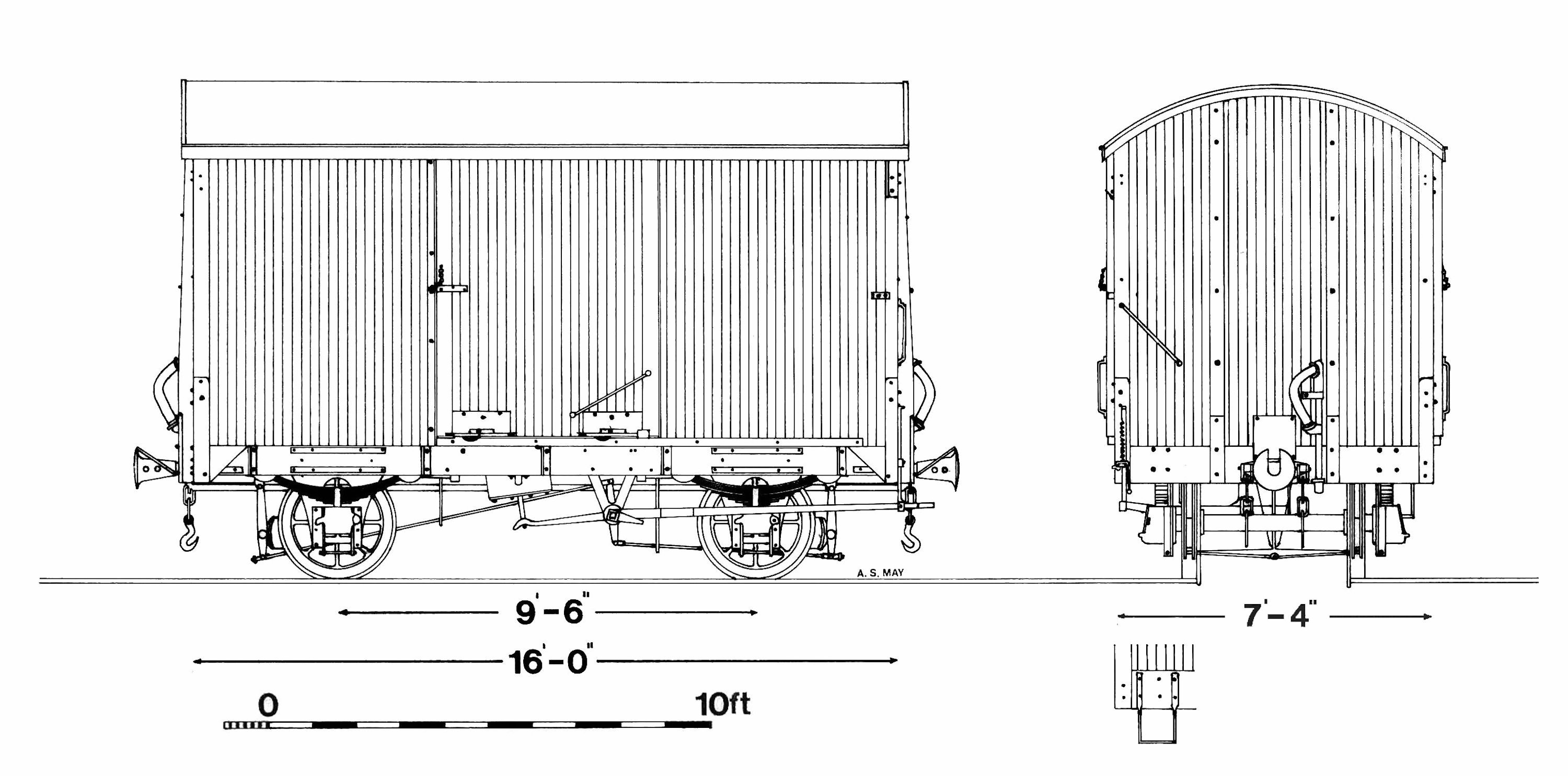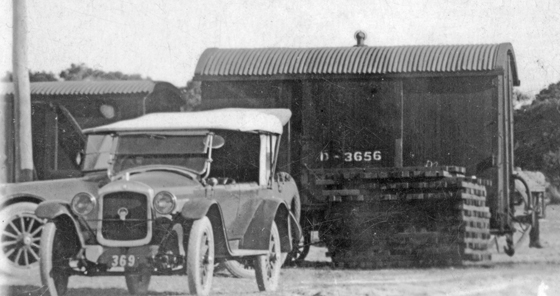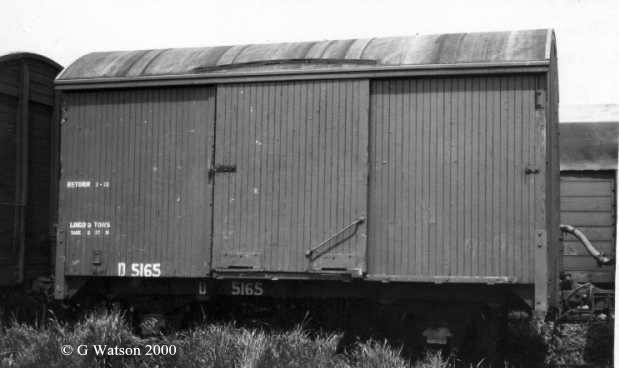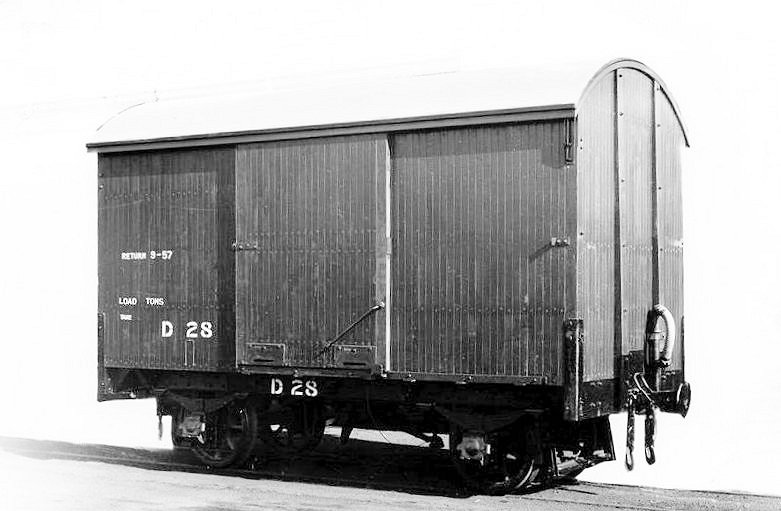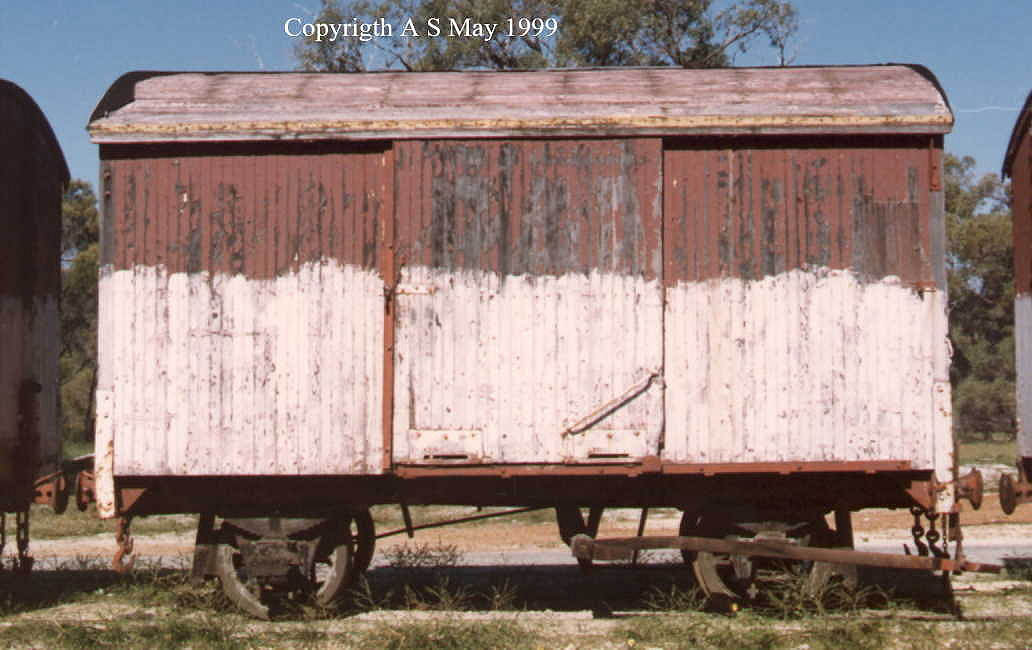| Class D (16'-0") vans |
| The final standard D van was this 16'-0" type which was similar in body style to the earlier 17'-0" and 15'-0" long vans. The change to the 16'-0" long chassis reflected the switch in open wagon construction from the 15'-0" long GB class to the 16'-0" GC class in 1907. The earlier 17'-0" long vans being built at the same time as the 17'-0" long GA class open wagons. Surprisingly the vans did not get separate classifications and all of them were lumped together as class D. This can produce problems in trying to work out exactly what happened as will become apparent. I have colour coded some of the numbers to try and make it a bit simpler to follow. |
D3656 at Busselton in the twenties from an old postcard. Note that the old ex GSR 14' D van next to it has also acquired a corrugated iron roof. |
| The following vans were definitely built new to this design in a period of just three years as follows: | |
| 1909 | 5001, 5002, 5005, 5008, 5143-5177, 5181, 6802-6811 built. These vans were built without vacuum brake which was fitted in 1910. |
| 1910 | 3, 1065 built |
| 1911 | 148, 153, 235, 247, 266, 423, 697, 737, 738, 748, 785, 961, 1100, 1132, 1450, 1451, 1506, 1540, 2034, 2286, 2337, 2624, 2762, 3652, 3656 built |
|
2983 is also listed on the D class record card as built in 1911 but this number also belonged to a Q class built to replace the original Q2983 sold to Smith and Timms at the same time. There is no mention on the D class record card of a D2983 being written off. Equally there is no mention of D3656 being built despite it featuring in the photo above and being written off in 1954. So it is likely to be an error on the card and that D3656 was built in 1911 rather than D2983. It is also known that some of the very old 14'-0" D vans were "rebuilt" from 1912 onwards (84, 250, 251, 253, 255, 264 and 267) and it is believed that these were replacement vehicles to the 16'-0" design. This may also have been the case with many of the 14'-0" ex GSR vans with 4180 and 4184 known to have been rebuilt in 1912 and 1914 respectively. D4159, 4174 and 4381 probably also fall into this category. However, some of these early vans could have been renewed as 15'-0" vans. It is also likely that all of the 1909 vans at least (3656, 5158 confirmed) were built with corrugated iron roofs. In fact the whole class may have been built like this but at the moment I cannot be certain. A batch of six P class brake vans (4994, 4995, 4997, 5007, 5009, 5010) were converted to D vans in 1913 and it is almost certain that they were in fact replaced by new 16'-0" D vans. Finally in 1928 old breakdown van 201 was replaced by a new D van. This was probably also a 16'-0" van. |
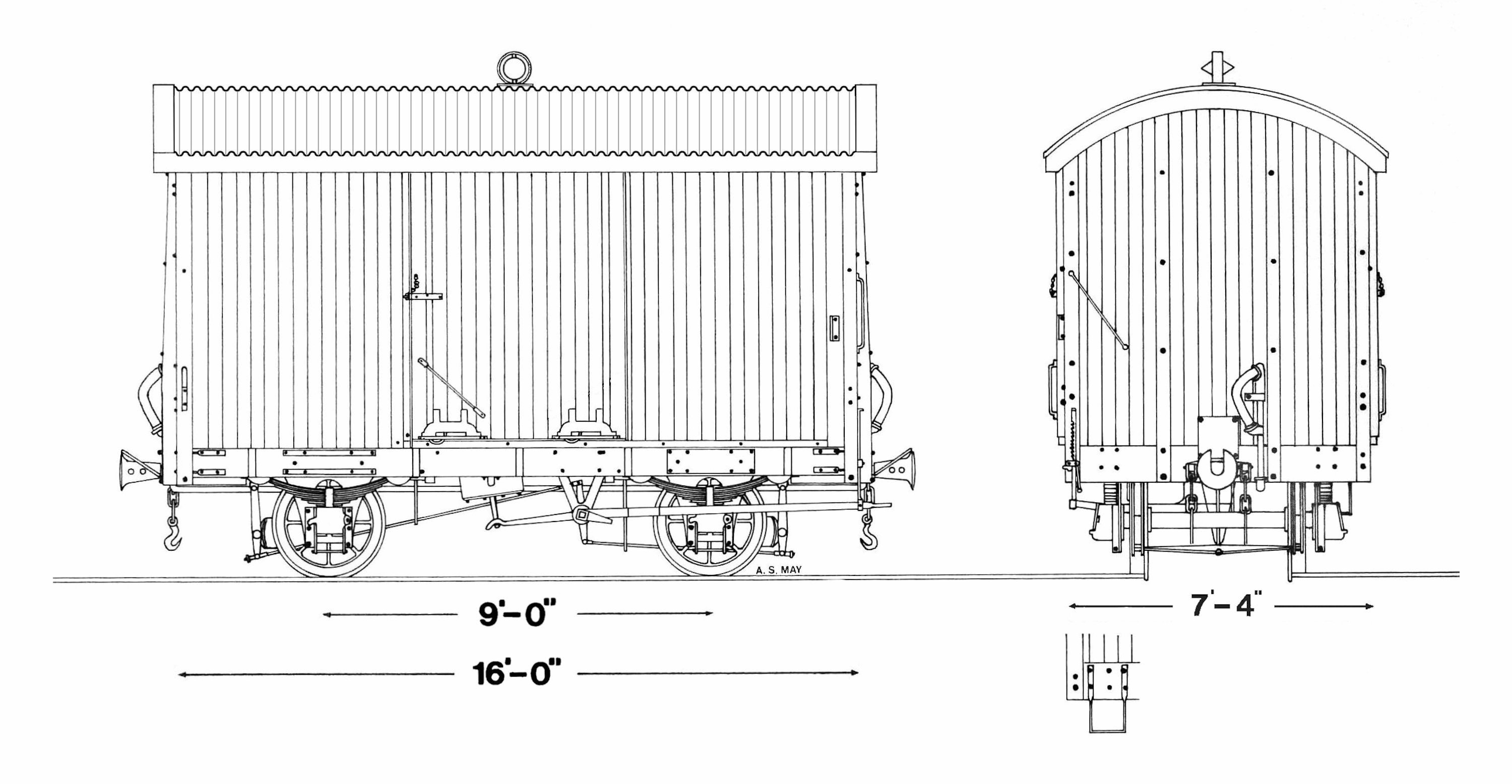
|
Withdrawal of the class started in 1931 with D5158. This particular van is illustrated in Jack Stanbridge's book "70 years of Rails & Wire in Western Australia" as an advertising van in a photo, which must have been taken before 1931, complete with corrugated iron roof. This van was almost certainly an accident victim as in all probability were the others written off over the next few years. |
| 1931 | 5158 written off |
| 1932 | 5009, 5173, 5175 written off |
| 1940 | 5144, 5164 written off
2624 converted to DA |
| 1943 | 5001, 5010 written off |
| 1945 | 5162 written off |
| It is very likely that D2624 was replaced by a new DA2624 in 1940 rather than being "converted". By the fifties this class were becoming life expired and so after the downgrading of some vans to DW class workmen's vans a re-bodying programme was started. This program did not last long, presumably because of the vast numbers of new DC and >FD> class vans coming into service. Further withdrawals started in 1954. |
| 1952 | 5167, 6810 reclassified DW |
| 1953 | 148, 153, 250, 423, 1132, 1506, 2337, 4994, 5002, 5148, 5153, 5156, 5171 reclassified DW
5154 missing at stock take 251, 961, 1451, 3652, 5008, 5149, 5150, 5151, 5152, 5165, 5166, 5170, 5172, 5176, 6803, 6804, 6809 re-bodied |
| 1954 | 5157, 5168 to DE
84, 201, 235, 255, 264, 697, 737, 738, 1065, 1450, 2034, 4995, 5005, 5159, 5163, 5174, 6802, 6807, 6808, written off |
| 1955 | 4997, 5143, 6805 written off |
| 1956 | 3, 267, 785, 5007, 5145, 5146, 5155, 5169, 6811 written off |
| 1957 | 5161 to DW
247, 253, 748, 1540, 2286, 5147, 5181, 6806 written off |
| 1958 | 5160 written off |
| 1960 | 5177 written off |
| 1961 | 1100 written off |
| 1962 | 266, 2762 written off |
|
The "re-bodying" programme of 1953 does, however, add a further complication in that it also included vehicles of the 15'-0" types including the N.Z.R. type vans. It is not clear what exactly happened but my bet would be that about 40 completely new vans were in fact constructed. D1184 was certainly a completely new 16'-0" van. A total of 40 vans is listed on the diagram, however, 45 are listed as having been re-bodied at the time so the possibility remains that some were simply new bodies of the old type. |
|
|
|
The vans involved in this programme were: 251, 961, 1451, 3652, 5008, 5149, 5150, 5151, 5152, 5165, 5166, 5170, 5172, 5176, 6803, 6804, 6809 ex 16-0" D van 559, 566, 1181,1184, 1185, 1189, 1191,1198, 1334, 1336, 1340, 1344, 1351 ex N.Z.R. type 5119 ex re-bodied horse box 4174 possibly 14'-0" ex GSR type D van 13, 25, 27, 28, 31, 33, 40, 55, 59, 149, 160, 4255, 6788 ex 15'-0" D van These vans were very similar to the 1909 design but had no roof ventilator and definitely did not have a corrugated iron roof. They are quite well recorded photographically as many ran as Advertising vans. |
|
WAGR official photo of D28 when new (RHWA collection) |
|
The WAGR outline diagram is shown below.
|
| Their fates were as follows: | |
| 1958 | 5119 written off |
| 1964 | 40, 59, 160, 251, 1191, 5152 reclassified DE |
| 1967 | 59 ex DE |
| 1968 | 961, 1344, 3652 written off |
| 1969 | 160 ex DE
55, 559, 1185, 1198, 1336 written off |
| 1970 | 28, 1351, 5165, 6788 written off (6788 to Woodman's point internal use) |
| 1971 | 27, 149, 1451, 4174, 5008, 5176 reclassified DE
25, 566, 1334 written off |
| 1972 | 31, 33, 1181, 1184, 1189, 4255, 5149, 5150,6803, 6804 written off |
| 1973 | 59 reclassified DE
160, 5151, 5170, 6809 written off |
| 1974 | 13, 5166 written off |
| 1977 | 1340, 5172 written off |
|
All of the vans reclassified DE had been withdrawn by 1978 but a number survived as internal user wagons at Woodman's point until the depot closed. As a group the 16'-0" D vans are a puzzle for historians and a nightmare for model makers unless you have a photograph showing a van dated to a particular period. I'm certain that the above is not 100% correct but at the moment it is my best shot. I would be glad of any more information. |
A rather battered late survivor at Woodman's point at least 10 years after it was written off. All of the 1953 vans had a distinctive steel fillet immediately behind the buffer beam not found on the earlier D vans. |
